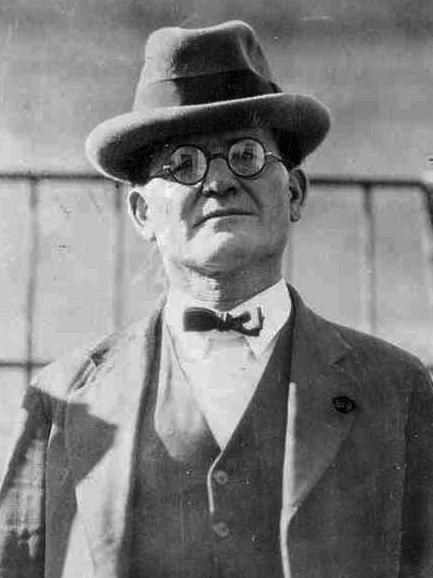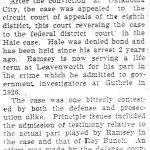February 1, 1929
Osage County News
Microfilm Roll: MN00308

Courtesy of the FBI
On this day in Osage country the Osage County News posted an article on the conviction of William K. Hale in the Osage Indian murders.
The 1920’s proved to be a terrifying and trying decade for the citizens of the Osage Indian Nation. Since the turn of the 20th century, the Osages had become the “wealthiest people on Earth” due to tribal royalties earned on Osage oil. Tribal members received headrights, or equal shares, of these royalties that could only be passed down through inheritance; the beneficiaries of which could include Osage and non-Osage peoples. It was also during this time that the Osage Nation began to see a peak in homicides. The rising numbers of murders sparked much fear in Osage Council members who ultimately reached out to the United States government for help in investigating these heinous crimes. In response to their plea of help, the Federal Bureau of Investigation (FBI), known at the time as the U.S. Bureau of Investigation, sent agents, some of who went undercover, to assist in solving the murders.
William K. Hale, also known as the “King of the Osage Hills,” was a local, prominent livestock raiser and landowner with many connections to important businessmen and political leaders (“Hale is Given Life Sentence”). Over the years, Hale had not only made connections with people of high rank, but also built a strong relationship with the Osages after leasing and buying thousands of acres of grazing lands from the Indians for several years. Not coming from a wealthy background, he is said to have been a “cowboy living in a tent” when he first arrived in Oklahoma, Hale was able to successfully work his way up the social ladder (Hogan, 114). In his book, The Osage Indian Murders, author Lawrence J. Hogan, former FBI agent and Congressman, claims Hale’s favorite “method of building up power and prestige was to bring various individuals under obligation to him by gifts or favors” (115). Seemingly more often or not, these individuals had a criminal past or were on the run; the type of people that would do anything for a price. Even so, Hale’s own criminal record was spotless.
In the summer of 1921, a body was found by a group of hunters in an isolated area near Fairfax, Oklahoma. The victim’s name was Anna Brown, a woman to whom William K. Hale was distantly related by marriage. Just two months after Brown’s death, her mother, and beneficiary of Anna’s headrights, Lizzie Q. Kile, died a suspicious death. Ms. Kile’s fortune was then “divided between her two surviving daughters Mollie Burkhart and Rita Smith” (60). In the winter of 1923, Anna’s cousin, Henry Roan was also found dead, his body discovered in a canyon sitting in an abandoned car. Hale not only helped carry the casket in Roan’s funeral, but was also the “beneficiary of Roan’s $25,000 life insurance policy” (“Hale is Given”). Within about a month and a half after the discovery of Roan’s body, Anna’s sister, Rita, was killed when her home suddenly exploded; her husband, who was suspicious of the previous murders, and her housemaid, an adolescent, were also killed in the explosion. Hale’s nephew, and foster son, Ernest Burkhart, and Ernest’s wife, Mollie, Anna Brown’s sister, received large sums of money as the beneficiaries to both Anna’s and Lizzie’s estates. Fortunately, for the sake of Mollie who was already being discreetly envenomed by her husband, the murders came to an abrupt stop in 1926 when William K. Hale, now known as the “Osage King of Crime,” and several other men were taken into custody.
After speaking with several witnesses and conducting many interrogations, investigators discovered that Hale was the mastermind behind this explicit murder plot, but had his men conduct the dirty work. It was not until January 26, 1929 that William Hale was sentenced to life imprisonment for the murder of Henry Roan by Judge Kennamer. He was later paroled in 1947 after serving only two decades of his sentence.
Morgan M. Guzman
“Hale is given Life Sentence.” The Osage County News. Feb. 1, 1929, p. 1. Microfilm roll number MN00308. Sequoyah National Research Center, Little Rock, Arkansas.
Further Reading
Hogan, Lawrence J. The Osage Indian Murders. Fredrick, MD.: Amlex Inc., 1998.
Linder, Douglas O. “The Osage ‘Reign of Terror Murder Trials: An Account.” http://www.famous-trials.com/osage-home/2378-the-osage-reign-of-terror-murder-trials-an-account (date accessed January 30, 2018)
May, John D. “Osage Murders.” The Encyclopedia of Oklahoma History and Culture. http://www.okhistory.org/publications/enc/entry.php?entry=OS005 (date accessed January 29, 2018)
“Murder and Mayhem in the Osage Hills.” Federal Bureau of Investigation. https://www.fbi.gov/history/famous-cases/murder-and-mayhem-in-the-osage-hills (date accessed January 29, 2018)
“Osage Indian Murders.” FBI Records: the Vault. https://vault.fbi.gov/Osage%20Indian%20Murders (date accessed January 29, 2018)
Source File(s)
Related Stories
- Indian All Set For Bad Times
- Chiefs of the Osage Receive Strange Letters
- Damage Asked in Sum of $125,000 of Osage Indian
